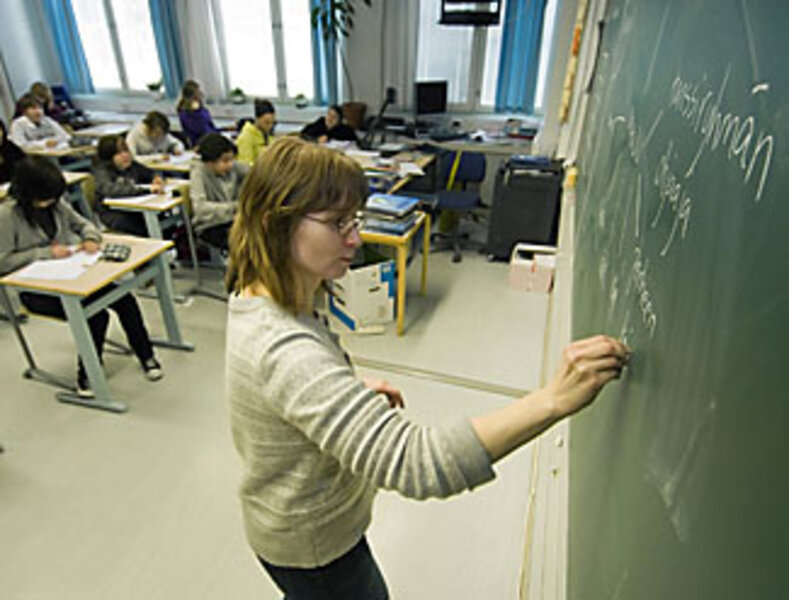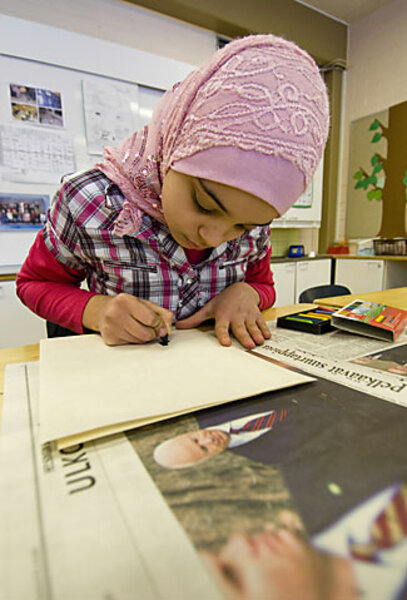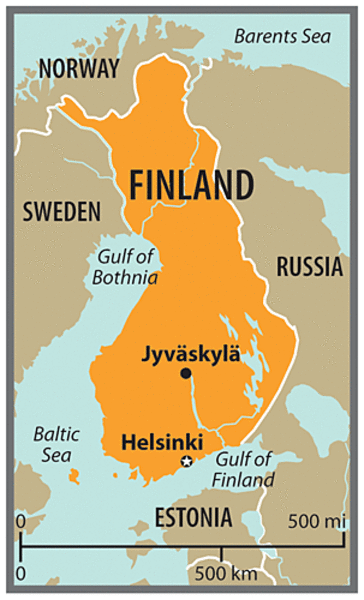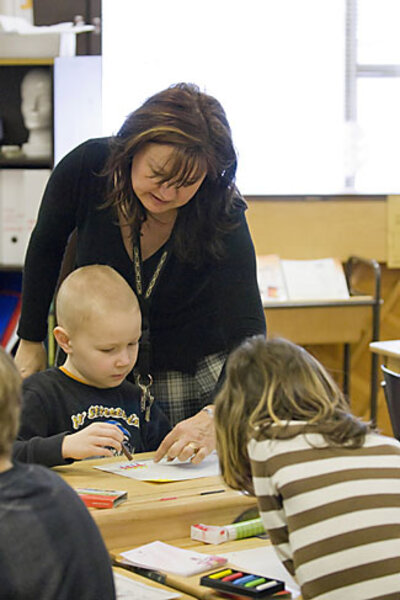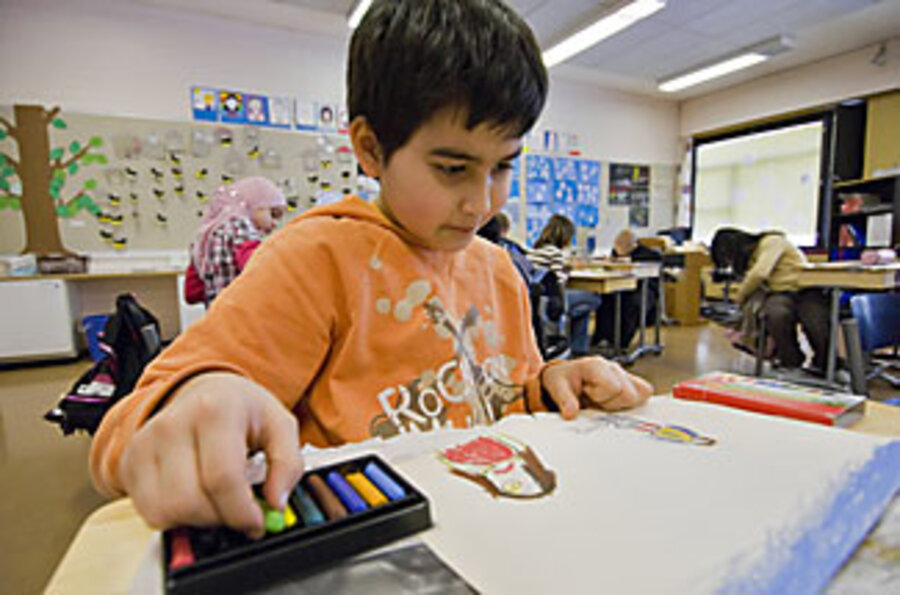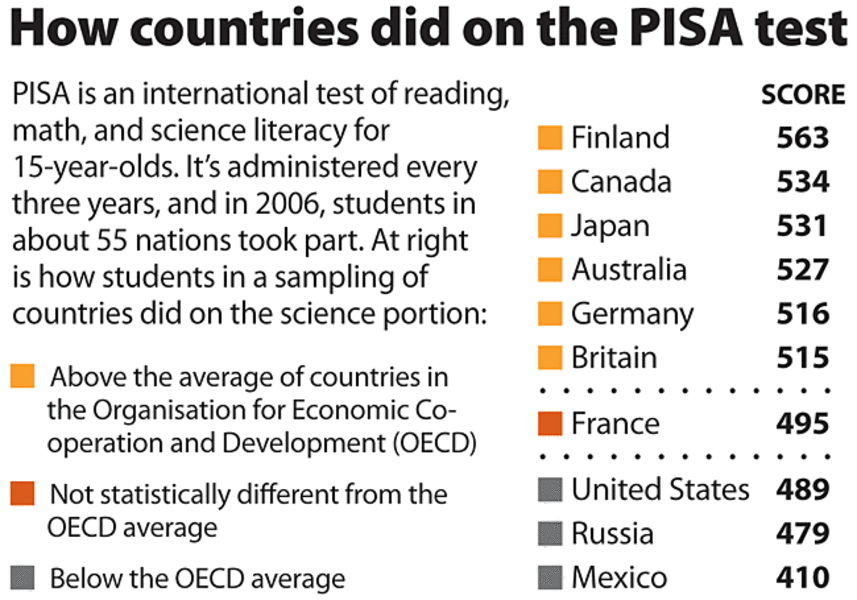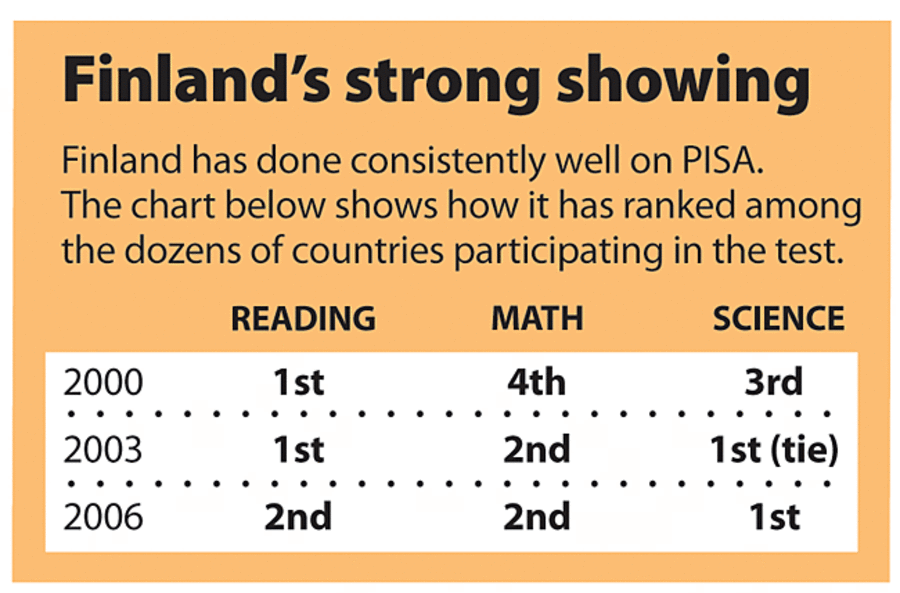Lessons from most successful schools abroad
Loading...
| Jyväskylä, Finland
After each 45-minute class, students at the Vaajakumpu Primary School in Finland suit up in their snow gear, and for 15 minutes, they frolic on ice skates, sleds, and skis.
These breaks provide a clear contrast between Finnish schools and their recess-starved counterparts in the United States. But it's not the contrasts on the surface that have prompted thousands of educators from around the world to visit this Nordic nation. Rather, it's their curiosity about what underlies an education system that boasts some of the highest scores among countries on PISA – a test of reading, math, and science literacy for 15-year-olds.
No single factor can explain the students' strong showing. They grow up in a highly literate, bilingual society (Finnish and Swedish, with most learning English as well). Finns also enjoy strong governmental supports for parental leave, day care, and healthcare (in exchange for high taxes), which means that problems associated with poverty don't show up at the schoolhouse door nearly as often as in the US.
One essential element, though, is the high caliber of Finland's teaching corps, education leaders say. "We trust our teachers," says Reijo Laukkanen, head of international relations at the Finnish National Board of Education in Helsinki. "That is very important, and it's not easy to realize in all countries – the culture of trust we have in Finland."
Since 1979, master's degrees have been required for teaching in primary and secondary schools. And the profession is so popular – even with its moderate salaries – that only 10 to 15 percent of applicants make it into university teacher-education programs.
A contrast with America
That selectivity "in and of itself is just such a huge difference from the US," says Kevin Carey, research and policy manager at Education Sector, an independent policy group in Washington. American education programs at universities don't tend to set difficult standards to get in, and top students aren't lining up at their doors, he and other experts say.
Perhaps that needs to change, some policymakers suggest as they eye not only Finland, but also a range of high-performing countries where the teaching profession is more selective.
Indeed, education trends from abroad are gaining cachet as political and educational leaders strive to bring American schools in line with the demands of the 21st-century global economy. Researchers cite effective practices from places as varied as Korea, Australia, Singapore, and Switzerland. (See story on Singapore's model and a roundup of practices in other nations.)
When it comes to improving education, "there's a globalism in the perspective of ... the high-achieving countries, [and] they're all talking about each other," says Linda Darling-Hammond, an education professor at Stanford University in California. "It's an important change that there's some interest in that now" in the US, she says.
And one focus is teaching, since high-quality teachers are important in improving student achievement.
The US should recruit, prepare, and support teachers in ways that "reflect the ... practices of top-performing nations and states around the world," urged a report released in December by an advisory group convened by the National Governors Association and several education organizations.
President Obama raised a similar idea in his recent speech on education: "The future belongs to the nation that best educates its citizens," he said. "[D]espite resources that are unmatched anywhere in the world, we've let our grades slip, our schools crumble, our teacher quality fall short, and other nations outpace us.... [That decline is] unsustainable for our democracy."
Yet observers caution that some attempts to compare US and international education can be too simplistic. "We can learn from other countries, but we do have to be careful with whether or not the practices of any one country can be imported into another," says Tom Loveless, a senior fellow at the Brookings Institution, a policy research group in Washington. "Many of these practices are so culturally bound that the fact that something works in Singapore doesn't necessarily mean it will work in the United States."
It's also worth noting that even in countries scoring higher than the US on certain tests, educators have their share of complaints and worries about the future. Moreover, it's not as if the lessons flow just one way: US schools and colleges regularly host foreign visitors interested in innovations they've tried.
The preparation to be a teacher
If Riina Haverinen were in the US, she'd probably be about to start a teaching job. She's nearly finished with her fourth year at the University of Jyväskylä in Finland, but she'll need two more to earn her master's degree in German, English, and teaching, she estimates. (Many Finnish students need just five years, depending on what they want to teach.)
In contrast to most beginning American teachers, she'll have a deep grasp of the subjects she'll be teaching, as well as the ability to conduct graduate-level research that can improve her work.
The university's lakeside campus, with sleek buildings designed by famous Finnish architect Alvar Aalto, is a major center for teacher education. University education is free in Finland, and students receive living stipends based on income.
The only subjects of study more popular than teaching are law and medicine, says Elisa Heimovaara, an international liaison in the Department of Teacher Education at the university. In fact, the profession has been popular for so long here that it's difficult to explain why. One reason, Ms. Heimovaara says, is that "it has been for many a person [a way] to climb the social ladder ... and improve one's economic situation."
It's difficult, however, for teaching programs to attract enough men: They make up just 1 out of 5 applicants. It's also hard to enlist people to teach math.
Ms. Haverinen chose teaching after observing her mother in the profession. "I like to be around kids and young people, and I really like German," she says.
This is the second year she's observing and teaching a range of subjects at several schools, including the Vaajakumpu school in the lake-district town of Jyväskylä. She was nervous initially, but that's faded as more-experienced teachers at the schools have shown her how to plan lessons.
The most challenging part so far, she says, is that "you cannot always teach in the same way; you have to see how the group is." That's why she's glad her training includes both theory and practice.
"We have to research our own teaching. It's really useful for us," she says, taking a break from supervising students who are working on German exercises at the Vaajakumpu school. She and a classmate, for instance, are researching oral communication and observing each other teach as part of the project.
Once students become teachers, they are expected "to update their skills and be curious about life and various subjects, so they are lifelong learners," says Heimovaara of the university.
In classrooms near Helsinki
The Länsimäki School in Vantaa, just outside Helsinki, is a good place to see the supportive environment in which Finnish teachers work, the skills they bring to the job, and the challenges they face.
Among the 700 students here in Grades 1 to 9 (generally ages 7 to 15), discipline problems are rare, says principal Tapio Lahtero. Teacher turnover is rare as well, with just three or four new hires necessary last summer. (Nationally, 5.7 percent of primary teachers leave the profession within three years – much lower than in the US.)
The school's curriculum was last revised in 2006, with teachers fully participating and receiving extra pay for the time spent. Each school details a curriculum in line with a national framework.
The national board does not administer high-stakes accountability tests. Rather, it samples students' skills periodically and gives feedback to schools (not the public) so they can see how they compare with the national average.
Teachers in Finland and a number of other high-performing countries are more involved than American teachers with creating curriculum and measuring whether students are really learning it. And this in turn develops the teachers' own understanding and effectiveness, says Ms. Darling-Hammond, who has researched teaching internationally.
In the US, states set standards, and school boards and administrators control much of the curriculum. For evaluating students, "We rely heavily on external tests, which come in brown paper wrappers ... and a machine scores them. Teachers don't really engage with that system," Darling-Hammond says.
While many American teachers have been chafing under the accountability systems of the federal No Child Left Behind law in recent years, autonomy is a hallmark of the teaching profession in Finland. "There's nobody who supervises if we follow [the curriculum]," says Marja Asikainen, a longtime English teacher at the Länsimäki School. "They trust us that we'll follow it, and Finnish teachers are rather free ... to do it in their own way."
Finnish teaching places a strong emphasis on helping students become independent thinkers. "We don't want to give only ready answers," says Liisa Norvanto, a primary teacher at the school. "We want to teach them to explore their surroundings.... We try to teach them how to compare knowledge ... and be critical."
American teachers share such goals, but some reformers say curriculum and testing need to be revised to encourage more critical thinking and problem solving.
Because teachers in Finland are thoroughly educated in the subjects they teach, as well as in child development and research strategies, they're expected to be able to address many individual learning needs. Students are not separated into different classes based on ability level, except when children go to special-education classes for part of the day if they have significant difficulties.
But the egalitarian approach and autonomy have downsides, too, Ms. Asikainen says. This has been particularly true as the numbers of special-education students and immigrants have increased. (About 30 percent of the students at this school come from immigrant families.) "We have some support, but I think it's not enough," she says. "We can discuss with each other [somewhat], but we have lots of problems, and we have to deal with them ourselves. Some of the teachers are very much alone."
More collaborative planning time is one priority of the national teachers union, which has nearly 120,000 members. Teachers get about three hours a week of paid planning time, and in this school, just one hour is required to be done with other teachers. The principal wishes the budget would allow for more. This is a desire shared by many US teachers, who typically get three to five hours a week for mostly individual planning time.
Another worry that's shared among Finnish and US teachers is what shrinking budgets in this down economy will do to class sizes. So far, Riitta Ufacik has managed to keep her Finnish-as-a-second-language classes to just five to 10 students (other subjects are typically 20 to 25). Small classes are key "so I can see a person, not only the group," she says. Today, for instance, her students include a 17-year-old from Kosovo and a younger teen who was born in Finland but whose parents speak Somali, and they're working on different skills.
In summing up why she loves teaching, Ms. Ufacik puts her finger on a source of satisfaction for educators around the world – something that policymakers can't force: "They honor my work," she says of her students.
• Part 3 will appear Friday.



